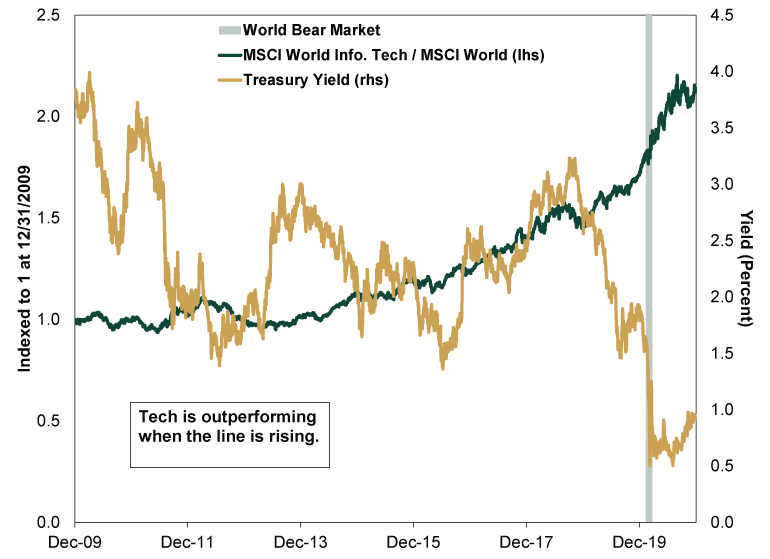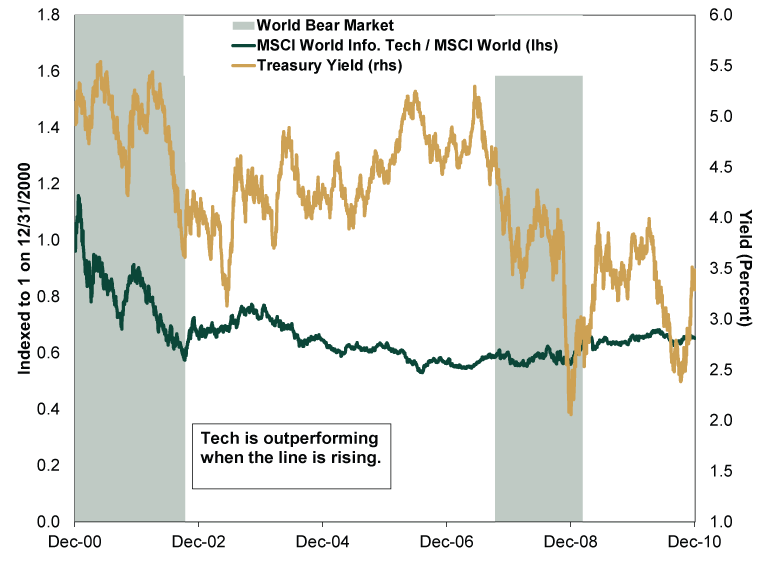Personal Wealth Management / Market Analysis
Why Rising Interest Rates Needn’t Stall Big Tech
Volatility under the hood is normal—don’t read too much into it.
Are Treasury markets hinting at trouble ahead for the Tech and Tech-like giants that have led this bull market higher? Some pundits say so, based on the observation that rising interest rates have coincided with short-term pullbacks in Tech stocks at various points this year, including the present. With the Fed signaling that quantitative easing (QE) will wind down soon, many think a continued rise in long rates means tough times for Tech and Tech-like firms from here. But history shows rising rates aren’t automatically negative for Tech stocks. While we don’t expect rising rates to persist, we still think that is worth keeping in mind.
According to those worried rising interest rates will weigh on Tech and Tech-like firms’ returns, when yields are low, investors are more willing to buy growth-oriented companies on the expectation of big future profits. But rising yields suggest investors feel more optimistic about the economy, so they supposedly prefer companies poised to benefit most from stronger economic activity in the present—ordinarily, value stocks. To back this claim, we have seen analysts cite a mix of recent data as interest rates have ticked higher. For example The Wall Street Journal reported on a $1.2 billion outflow from Tech mutual and exchange-traded funds in the week ending September 22—the first net withdrawal in three months.[i] Others noted that Tech stocks fell when interest rates rose this year, using a Tech-heavy ETF as a proxy for the sector.[ii]
But looking beyond what just happened shows reality isn’t so simple. Recent history proves Tech can do just fine alongside rising rates. From July 25, 2012 to 2013’s end, the 10-year Treasury yield rose from 1.43% to 3.04%.[iii] Tech rose 36.9% over that stretch—a bit behind global markets’ 42.3%, but still up nicely.[iv] Or consider when the Treasury yield climbed from 1.37% to 3.24% between July 8, 2016 and November 8, 2018.[v] Tech’s 69.7% return over that timeframe more than doubled global stocks’ 30.8%.[vi]
Taking a longer perspective, Tech has both risen and fallen in a variety of interest rate environments—there isn’t a set pattern. Over the past two decades, the correlation between Tech’s relative returns and Treasury yields was -0.10.[vii] A correlation of 1.00 means the datasets have identical movement while -1.00 means the assets move completely inversely to each other, so a -0.10 correlation implies not much relation at all.
Exhibits 1 and 2 display this lack of correlation visually. Just as rates’ swings didn’t impede Tech stocks’ leadership for much of 2010 – 2020, they didn’t prevent the sector’s lag for most of the 2001 – 2010 period.
Exhibit 1: No Interest Rate/Tech Correlation, 2010 – 2020

Source: FactSet, as of 10/4/2021. MSCI World Information Technology and MSCI World returns with net dividends and 10-year US Treasury yield, 12/31/2009 – 12/31/2020.
On the flipside, Tech lagged the broader market in the 2000 – 2010 decade—but Treasury yields didn’t tell you much about Tech’s returns then, either. (Exhibit 2)
Exhibit 2: No Interest Rate/Tech Correlation, 2001 – 2010

Source: FactSet, as of 10/4/2021. MSCI World Information Technology and MSCI World returns with net dividends and 10-year US Treasury yield, 12/31/2000 – 12/31/2010.
Now, as some have observed, rising long-term interest rates could steepen the yield curve, which tends to benefit value-oriented companies. Value firms, which are usually lower credit quality, typically depend heavily on bank lending for capital, as they can’t access capital markets as easily as big growth firms. Banks borrow short term to fund long-term loans. Hence, the gap between short and long rates is a proxy for banks’ net interest margins—the potential profit on new loans. With short rates near zero, rising long rates mean a bigger potential profit. That makes risk-taking a more worthwhile endeavor, which is why a steeper yield curve incentivizes banks to lend to a wider swath of borrowers.
But we don’t think long-term interest rates will keep shooting higher and stay elevated. Inflation is the primary determinant of long rates. While inflation rates are elevated presently, we think these stem from a combination of passing factors, e.g., economic reopenings and global supply shortages/bottlenecks. The likelihood they continue driving fast price gains from here seems low, especially given all the investment pouring into new production capacity. In our view, inflation likely returns to its slower pre-pandemic rate. Note, too, tapering QE didn’t have a lasting impact on rates in 2013 and 2014.
In our experience, volatility under the hood is normal, and reacting to it can be as dangerous as reacting to pullbacks. Broad markets don’t move in gradual, smooth lines—and neither do the market’s subcategories. Moreover, countertrends at the sector and style level often accompany volatility, and this can end as quickly as it begins. In our view, reacting to short-term, unpredictable movements can invite errors. Instead, we suggest investors look beyond the immediate short term and look to the 3 – 30 month timeframe markets typically weigh.
As turbulent as the past several weeks have been, the longer-term economic factors stocks care about haven’t much changed, in our view. Most major economies are near or above pre-pandemic levels of output—and growth is slowing as expected following a reopening-related pop. This slow-growth environment likely resembles the pre-pandemic environment, which favored big, growth-oriented firms—the kind that boast big gross margins that can buffer against the kind of cost pressures plaguing other industries today. Tech and Tech-like stocks did best in that pre-COVID environment, and we expect them to continue leading despite the occasional countertrend.
H/T Fisher Investments Research Analyst Tim Schluter and Research Associate Carson Paull
[i] “Bond-Yield Surge Challenges Investor Confidence in Big Tech Companies,” Amrith Ramkumar, The Wall Street Journal, 9/29/2021.
[ii] “Are Rising Interest Rates Bad For Tech Stocks?” Ben Carlson, A Wealth of Common Sense, 9/30/2021.
[iii] Source: FactSet, as of 10/4/2021. US Treasury Yield, 7/25/2012 – 12/31/2013.
[iv] Ibid. MSCI World and MSCI World Information Technology returns with net dividends, 7/25/2012 – 12/31/2013
[v] Ibid. US Treasury Yield, 7/8/2016 – 11/8/2018.
[vi] Ibid. MSCI World and MSCI World Information Technology returns with net dividends, 7/8/2016 – 11/8/2018.
[vii] Source: FactSet, as of 10/5/2021. US 10-Year Treasury Yield and MSCI World and MSCI World Information Technology returns with net dividends, 12/31/2000 – 12/31/2020. Correlation calculation uses weekly change in MSCI World Index / MSCI World Information Technology Index, indexed to 1 at 12/31/2000, and weekly change in 10-Year Treasury yield starting on 12/31/2000.
If you would like to contact the editors responsible for this article, please message MarketMinder directly.
*The content contained in this article represents only the opinions and viewpoints of the Fisher Investments editorial staff.
Get a weekly roundup of our market insights
Sign up for our weekly e-mail newsletter.

You Imagine Your Future. We Help You Get There.
Are you ready to start your journey to a better financial future?

Where Might the Market Go Next?
Confidently tackle the market’s ups and downs with independent research and analysis that tells you where we think stocks are headed—and why.





